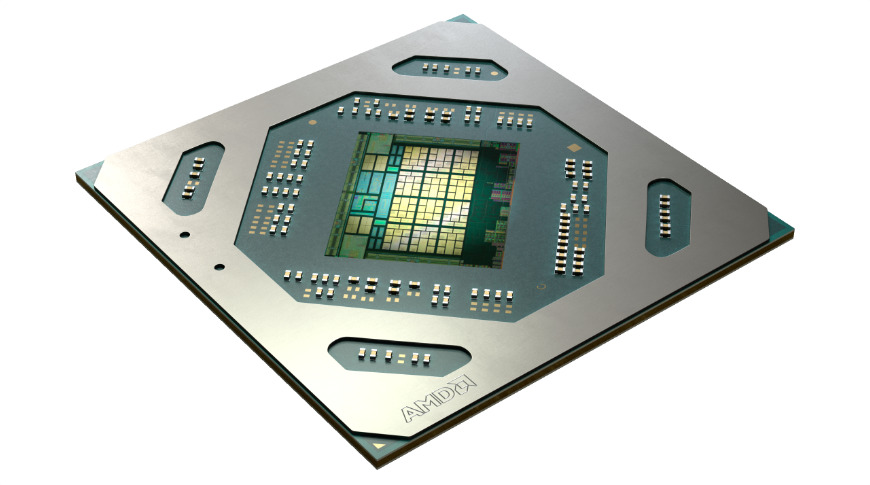AMD has revealed the specifications of the new Radeon Pro 5000M-series GPU options available in the just-launched 16-inch MacBook Pro, with the Radeon Pro 5300M and 5500M offering better graphics performance and an option for up to 8GB of GDDR6 VRAM.
Introduced as part of Apple's launch of the 16-inch MacBook Pro, the Radeon Pro 5000M-series graphics processing units offer a significant bump in performance compared to the previous options available for the 15-inch MacBook Pro.
Alongside the integrated Intel graphics, the new MacBook Pro models are equipped with a Radeon Pro 5300M with 4GB of GDDR6 memory in the base model, while the second base option includes a Radeon Pro 5500M, again with 4GB of GDDR6 memory. Upgrades are available in both cases, from the 5300M to the 5500M, as well as from the 5500M with 4GB of VRAM to the same GPU but with 8GB of VRAM.
| Radeon Pro 5500M | Radeon Pro 5300M | Radeon Pro Vega 20 | Radeon Pro Vega 16 | Radeon Pro 560X | Radeon Pro 555X | |
|---|---|---|---|---|---|---|
| MacBook Pro Model | 16-inch Late 2019 | 16-inch Late 2019 | 15-inch Mid 2019 | 15-inch Mid 2019 | 15-inch Mid 2019 | 15-inch Mid 2019 |
| VRAM | 4GB or 8GB GDDR6 | 4GB GDDR6 | 4GB HBM2 | 4GB HBM2 | 4GB GDDR5 | 4GB GDDR5 |
| Compute Units | 24 | 20 | 20 | 16 | 16 | 12 |
| Stream Processors ("Shaders") | 1,536 | 1,280 | 1280 | 1024 | 1024 | 768 |
| Max Performance (FP32 in TFlops) | 4.0 | 3.2 | 3.2 | 2.4 | 2.0 | 1.4 |
| Peak Engine Clock | 1,300MHz | 1,250MHz | 1,283MHz | 1,190MHz | 1,004MHz | 907MHz |
| GPU Process Size | 7nm | 7nm | 14nm | 14nm | 14nm | 14nm |
The Radeon Pro 5000M series is made using AMD's new RDNA architecture, as seen in its graphics cards, and are billed as the first discrete mobile GPUs that are made using a 7-nanometer process. The use of GDDR6 enables up to 192 gigabytes per second of memory bandwidth, twice that of GDDR5, though only the 5500M can use 8GB of the memory while the 5300M is limited to 4GB.
The Radeon Pro 5500M GPU is equipped with 24 compute units, 1,536 stream processors, a peak engine clock of 1,300MHz, and can provide up to 4 teraflops of single-precision floating-point performance. The Radeon Pro 5300M GPU has 20 compute units and 1,280 stream processors, along with a peak engine clock of 1,250MHz, giving it up to 3.2 teraflops of performance.
Based on the standard configurations, Apple claims consumers will enjoy 2.1 times faster graphics performance than the GPUs used in the previous standard configuration. In the 15-inch MacBook Pro, this would have consisted of a Radeon Pro 555X or a Radeon Pro 560X, both with 4GB of VRAM.
In a comparison of the highest-performing GPUs for each, consisting of the Vega 20 with 4GB of VRAM against the 8GB Radeon Pro 5500M, Apple claims there is an 80-percent increase of graphical performance for the 16-inch MacBook Pro's GPU. Effects rendering for color grading in DaVinci Resolve is 1.8 times faster in the new model over the previous one, while 1.6-times faster performance is touted for "Fortnite."
 Malcolm Owen
Malcolm Owen







-m.jpg)






 Bon Adamson
Bon Adamson
 Marko Zivkovic
Marko Zivkovic
 Wesley Hilliard
Wesley Hilliard
 Amber Neely
Amber Neely


 William Gallagher
William Gallagher




-m.jpg)



26 Comments
Pretty impressive.
Given that Intel did NOT fix the Meltdown/Spectre exploit, even on the new family of their processors - this means that all of their current offerings were INTENTIONALLY left open. So, perhaps Apple may want to consider offering some Mac's with AMD processor families; in the interest of security.
No slouch... although I find it funny that Apple have chosen Matlab as one of the benchmarks for the new MBP. For years now, the only GPGPU that Matlab has supported is with NVidia cards through CUDA, which makes this excellent card from ATI quite useless (at least for that scenario).
How is this compared to the latest NVidia offerings in mobile?
What is the true advantage of these high performance video cards and what is a use case that justifies them?